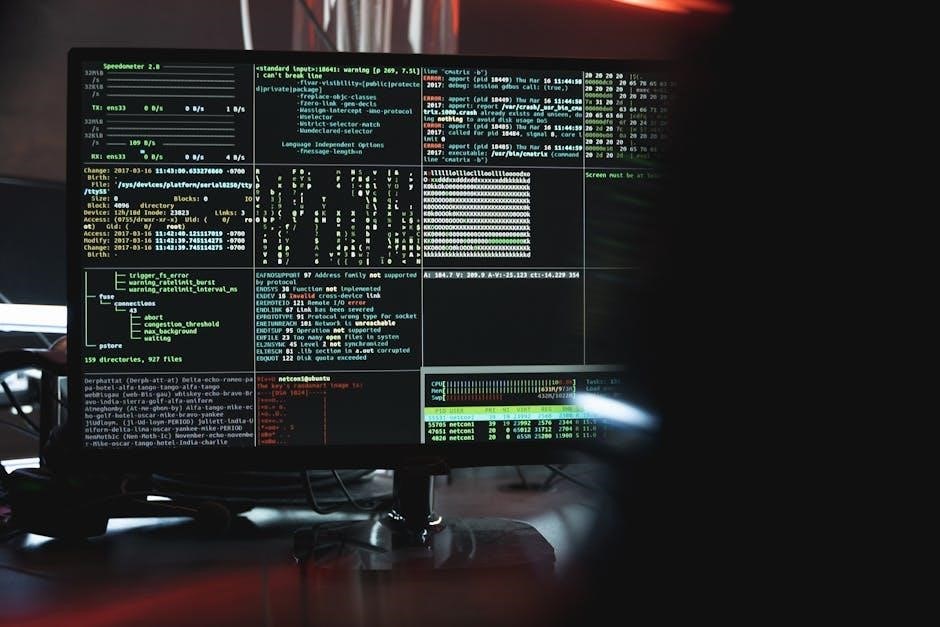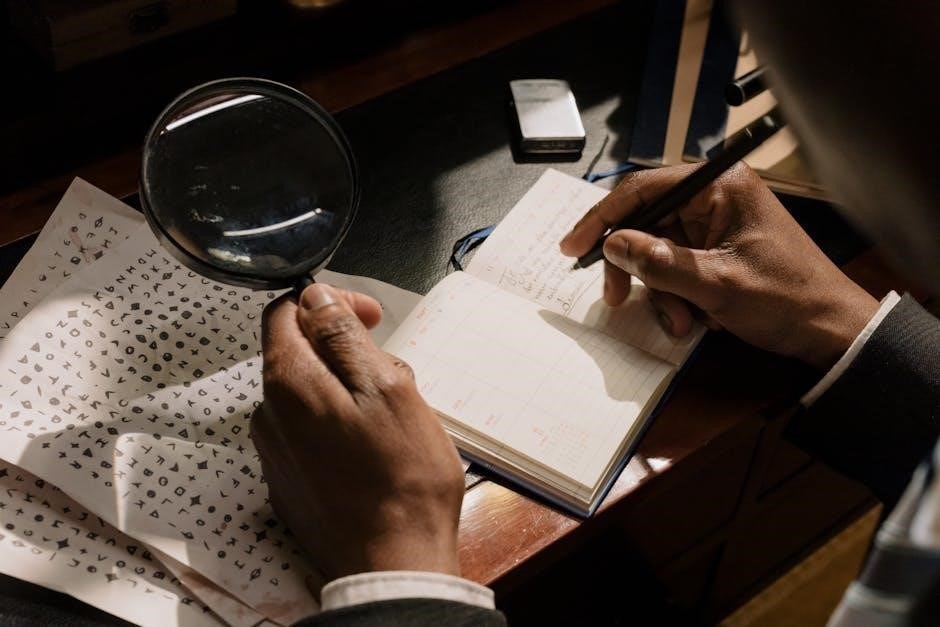Overview of CPT Coding for Liver Biopsy
CPT coding for liver biopsy ensures accurate billing and reimbursement for medical procedures. It involves specific codes for biopsy types and imaging guidance, with 47000 for needle biopsies and 77012 for CT guidance. Proper coding prevents errors and ensures correct payment, requiring separate reporting of biopsy and imaging services. Understanding guidelines is crucial for precise documentation and compliance with coding standards.
1.1. Importance of Accurate CPT Coding
Accurate CPT coding is crucial for correct payment, compliance, and avoiding billing errors. Incorrect coding can lead to denied claims, audits, or revenue loss. Proper coding ensures clarity in medical documentation and adherence to regulatory standards. It also helps in distinguishing between procedures, such as biopsy and imaging guidance, preventing unbundling issues. Precise coding supports efficient billing and maintains the integrity of medical records and reimbursement processes.
1.2. Key Components of CPT Codes for Liver Biopsy
CPT codes for liver biopsy include specific procedure codes and imaging guidance codes. The primary code, 47000, represents a needle biopsy of the liver, while 77012 is used for CT guidance during the procedure. These codes are designed to capture the distinct aspects of the biopsy process, ensuring accurate billing and reimbursement. Proper use of these codes requires understanding their definitions and application guidelines to avoid coding errors.

CPT Code 47000: Biopsy of Liver, Needle
CPT code 47000 is used for a percutaneous needle biopsy of the liver. It represents the procedure itself, excluding imaging guidance, which requires a separate code like 77012.
2.1. Description of CPT Code 47000
CPT code 47000 describes a percutaneous needle biopsy of the liver. This procedure involves inserting a needle through the skin to obtain liver tissue for pathological examination. It is typically used to diagnose liver conditions such as inflammation, fibrosis, or cancer. The code applies to biopsies performed without imaging guidance, as imaging is billed separately using codes like 77012.
2.2. When to Use CPT Code 47000
CPT code 47000 is used for a percutaneous needle biopsy of the liver performed without imaging guidance. It applies when the biopsy is a standalone procedure, not part of a larger surgery. The code is appropriate for obtaining liver tissue samples to diagnose conditions like inflammation, fibrosis, or cancer. Imaging guidance, if used, requires a separate code like 77012.

CPT Code 77012: Computed Tomography Guidance for Needle Placement
CPT code 77012 is used for CT guidance during needle placement for procedures like liver biopsies. It ensures precise targeting and is billed separately from the biopsy procedure.
3.1. Description of CPT Code 77012
CPT code 77012 describes computed tomography guidance for needle placement during procedures like liver biopsies. It covers the imaging component, ensuring precise targeting of the biopsy site. This code is used when CT scans guide the needle placement, enhancing accuracy and safety. It is billed separately from the biopsy procedure itself, such as CPT code 47000, and is essential for proper documentation and billing purposes.
3.2. Role of CT Guidance in Liver Biopsy
CT guidance in liver biopsy enhances precision by providing real-time imaging, helping to accurately target the biopsy site. It minimizes complications by avoiding vital structures and improves patient safety. This imaging technique is particularly useful for complex cases, such as deep-seated lesions or difficult anatomy. CT guidance ensures optimal needle placement, making the procedure more effective and efficient for both physicians and patients.

Procedure Overview: CT-Guided Liver Biopsy
A minimally invasive procedure combining CT imaging guidance with liver biopsy, enabling precise tissue sampling. It improves accuracy, reduces complications, and is ideal for complex cases.
4.1. Steps Involved in the Procedure
The CT-guided liver biopsy involves several key steps: pre-procedure imaging, patient positioning, administration of local anesthesia, insertion of the biopsy needle under CT guidance, collection of the liver specimen, and post-procedure monitoring. Each step ensures precise targeting and minimizes complications, integrating imaging and biopsy expertise for accurate diagnosis.
4.2. Imaging Guidance Techniques
CT guidance enhances the precision of liver biopsy by providing real-time imaging. The CT scan visualizes the needle’s path, ensuring accurate targeting of the liver tissue. This technique minimizes complications and improves diagnostic accuracy. It allows for adjustments during the procedure, offering a safer approach, especially for deep or difficult-to-access lesions, making it a preferred method for complex cases.

Clinical Scenarios for CT-Guided Liver Biopsy
CT-guided liver biopsy is ideal for evaluating abnormal imaging findings, diagnosing liver masses, or assessing diffuse liver disease. It aids in confirming cancer, cirrhosis, or fatty liver disease, ensuring accurate tissue sampling for diagnosis and treatment planning, while minimizing risks for patients with complex anatomy or high-risk conditions.
5.1. Indications for Liver Biopsy
Liver biopsy is indicated for diagnosing liver masses, cirrhosis, or fatty liver disease. It helps confirm malignancy, assess liver damage extent, and monitor chronic conditions like hepatitis. CT guidance improves accuracy in targeting suspicious areas, especially for patients with complex anatomy or high-risk bleeding profiles, ensuring precise tissue sampling for effective treatment planning and patient management.
5.2. Contraindications and Precautions
Contraindications for CT-guided liver biopsy include uncorrected coagulopathy, severe liver dysfunction, and thrombocytopenia. Precautions involve patients with ascites, biliary obstruction, or severe obesity, as these conditions increase procedural risks. Imaging guidance helps mitigate risks in high-risk patients, but careful patient selection and bleeding risk assessment are essential to ensure safety and avoid complications during the procedure.

Coding Guidelines for CT-Guided Liver Biopsy
CPT coding requires separate reporting of liver biopsy (47000) and CT guidance (77012). Ensure accurate documentation and avoid bundling codes to prevent billing errors.
6.1. Separate Reporting of Imaging Guidance
Imaging guidance for CT-guided liver biopsy must be reported separately using CPT code 77012. This code represents the radiologist’s work in guiding the needle placement. The biopsy procedure itself, coded as 47000, is billed separately, ensuring accurate reimbursement. Failure to report these codes separately may result in denied claims or underpayment. Proper documentation of both services is essential for compliance and correct billing practices.
6.2. Bundling and Unbundling Codes
Bundling codes for CT-guided liver biopsy is incorrect, as imaging guidance (CPT 77012) and the biopsy procedure (CPT 47000) are distinct services. Unbundling ensures proper reimbursement by reporting each service separately. Incorrect bundling may lead to denied claims or underpayment. Always verify payer guidelines to avoid coding errors and ensure compliance with billing regulations. Accurate code separation is vital for fair reimbursement and adherence to coding standards.
Billing and Documentation Tips
Accurate CPT coding for CT-guided liver biopsy requires using 47000 for the biopsy and 77012 for imaging guidance. Ensure clear documentation of medical necessity, patient history, and procedure details to avoid billing errors and ensure accurate reimbursement.
7.1. Proper Documentation for CPT Code 47000
Proper documentation for CPT code 47000 requires detailing the medical necessity, patient history, and procedure specifics. Include the type of biopsy, imaging guidance used, and any complications encountered. Ensure the biopsy site, needle type, and specimen collection are clearly noted. Accurate documentation supports correct billing and avoids reimbursement issues, ensuring compliance with coding guidelines and payer requirements.
7.2. Avoiding Common Coding Errors
To avoid errors, ensure CPT code 47000 is used only for needle liver biopsies without imaging guidance. Always verify the procedure details and patient records. Separate reporting of imaging codes like 77012 is essential, as they are not included in 47000. Avoid bundling codes for biopsy and guidance. Double-check documentation to prevent incorrect code usage, ensuring compliance with coding guidelines and accurate reimbursement.

Special Cases and Exceptions
Special cases include laparoscopic biopsies, which may require unlisted codes like 47379 when no specific CPT code exists. Always verify procedure specifics and coding guidelines.
8.1. Laparoscopic vs. Percutaneous Biopsy
Laparoscopic biopsies may require unlisted codes like 47379 when performed alongside other laparoscopic procedures, as no specific CPT code exists. Percutaneous biopsies, however, are coded with 47000 for needle biopsies. Imaging guidance, such as CT scans, is separately reported using 77012. Understanding these distinctions ensures accurate coding for different biopsy approaches, avoiding billing errors and ensuring proper reimbursement.
8.2. Unlisted Procedures and Alternative Codes
When a liver biopsy procedure doesn’t have a specific CPT code, unlisted codes like 47379 may be used. This often applies to laparoscopic biopsies performed with other procedures. Documentation must detail the procedure’s uniqueness to justify the unlisted code. Additionally, imaging guidance like CT (code 77012) is separately reported, ensuring accurate billing even for unconventional biopsy methods.

FAQs About CPT Coding for CT-Guided Liver Biopsy
Frequently asked questions include clarifying the use of CPT codes 47000 and 77012, understanding imaging guidance billing, and addressing scenarios with unlisted procedures or alternative codes.
9.1. What Is the Difference Between CPT Codes 47000 and 47001?
CPT code 47000 is for a standalone needle biopsy of the liver, while 47001 is used when the biopsy is performed during another major procedure. Code 47001 is an add-on code and should be billed separately alongside the primary procedure code. This distinction ensures accurate billing for different clinical scenarios involving liver biopsies.
9.2. Can CPT Code 77012 Be Used for Other Guidance Methods?
CPT code 77012 specifically refers to computed tomography guidance for needle placement. It is not applicable for other imaging modalities like ultrasound or MRI. Separate codes exist for different guidance methods, ensuring precise billing. Always verify the imaging modality used to select the correct guidance code, as 77012 is exclusively for CT-guided procedures.
Accurate CPT coding for CT-guided liver biopsies ensures proper billing and patient care. Use codes 47000 and 77012 correctly, adhering to guidelines for separate reporting and compliance.
10.1. Summary of Key Points
CPT coding for CT-guided liver biopsies involves using codes 47000 for the biopsy and 77012 for CT guidance. Accurate coding ensures proper billing and compliance. Separate reporting of biopsy and imaging services is required. Proper documentation is essential to prevent errors and ensure correct reimbursement. Understanding these guidelines helps maintain compliance and supports effective patient care delivery.
10.2. Final Thoughts on Accurate Coding Practices
Accurate CPT coding is foundational for correct billing and compliance. Using codes like 47000 and 77012 ensures proper reimbursement. Separate reporting of biopsy and imaging services is essential. Proper documentation and adherence to guidelines prevent errors. Stay updated on coding changes to maintain compliance. These practices ensure efficient, accurate, and compliant billing, ultimately supporting high-quality patient care and operational integrity.


